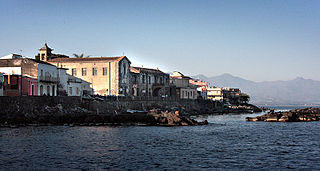
Noto is a city and comune in the Province of Syracuse, Sicily, Italy. It is 32 kilometres (20 mi) southwest of the city of Syracuse at the foot of the Iblean Mountains. It lends its name to the surrounding area Val di Noto. In 2002 Noto and its church were declared a UNESCO World Heritage Site.

The Palazzo Buonaccorsi is an 18th-century aristocratic palace, now the civic museum of the town, located on Via Don Minzoni 24 in the historic center of Macerata, region of Marche, Italy.

Palazzo Ajutamicristo is a Late-Gothic and Renaissance-style aristocratic palace located on VIa Garibaldi #23 of the ancient Kalsa quarter of Palermo, region of Sicily, Italy. It rises about a block south of Piazza Rivoluzione.
Max Crivello is an Italian illustrator, painter, screenwriter and art cartoonist.

Palazzo Abatellis is a palazzo in Palermo, Sicily, southern Italy, located in the Kalsa quarter. It is home to the Galleria Regionale della Sicilia, the Gallery of Art for the Sicilian region.

Palazzo Isnello is an historic palazzo situated between the ancient via del Cassaro and Piazza Borsa, in the Kalsa quarter of Palermo, Sicily.

Vito D'Anna was an Italian painter, considered the most prominent painter of Palermitan rococo and one of the most important artists of Sicily.

The Palazzo Riso, or RISO, Museo d’Arte Contemporanea della Sicilia, is a regional contemporary art museum located in the ancient Corso Vittorio Emanuele, Palermo, Italy.

The Sicilian Parliament was the legislature of the Kingdom of Sicily.

Francesco Lojacono or Lo Jacono (1838–1915) was an Italian painter, mainly of landscapes and seascapes, and mainly active in his native Palermo, Sicily.

Michele Tripisciano was an Italian sculptor.

Mario Francese was an Italian crime reporter of the Giornale di Sicilia. He was the first journalist to expose the role of Toto Riina and the Corleonesi within the Sicilian Mafia, and because of this he was killed on January 26, 1979. After 22 years, in 2001, those who had decided to eliminate him were convicted.

Torre Archirafi is a frazione of the comune (municipality) of Riposto in the Catania area of southern Italy. The small fishing village is located about 32 kilometres (20 mi) northeast of Catania and about 3 kilometres (1.9 mi) south of Riposto.
Lanza are a family of the Sicilian nobility descended from the Dukes of Bavaria.

The Modern Art Gallery of Palermo is a civic art gallery of Palermo, displaying works from the 19th until the early 20th century, located on Via Sant'Anna #21, adjacent to the church of Sant'Anna la Misericordia in the ancient quarter of the Kalsa of the city of Palermo, region of Sicily, Italy. The collections were moved to this site, consisting of the former Franciscan convent associated with Sant'Anna and the adjacent Palazzo Bonet.

Michele Catti was an Italian artist, considered one of the most important Sicilian landscape painters of the Belle Époque.

The Palazzo Alliata di Villafranca is former aristocratic mansion, now converted into a museum, located just off Via Vittorio Emanuele facing the Piazza Bologni which opens two blocks west of the Quattro Canti intersection, in the ancient quarter of the Albergaria of the city of Palermo, region of Sicily, Italy.
The Diocesan Museum of Palermo is a museum of religious art in Palermo on Sicily, housed in a number of rooms in the Palazzo Arcivescovile opposite Palermo Cathedral.

The Palazzo Branciforte is Renaissance-style aristocratic palace located on Via Bara dell'Olivella, in the historic center of Palermo, region of Sicily, Italy. It underwent extensive refurbishment under the direction of the architect Gae Aulenti, and since completion of the work in 2012 has been the home of the Fondazione Sicilia, and houses a modern library, auditorium, and exhibition halls.

The Palazzo Butera is a Baroque-style aristocratic palace located facing the Mediterranean in the ancient quarter of Kalsa of central Palermo, region of Sicily, Italy. On the shoreside, the long facade has a wide terrace, built atop the base of the former walls and called Passeggiata delle Cattive, in front of this is the park Foro Italico, in front, rising just south of Porta Felice and Via Vittorio Emanuele ; the access to the palace is from the land-side street of Via Butera.


















